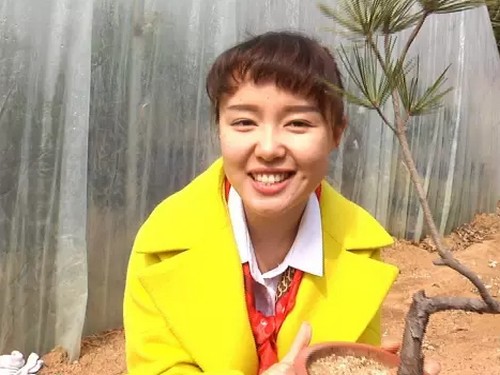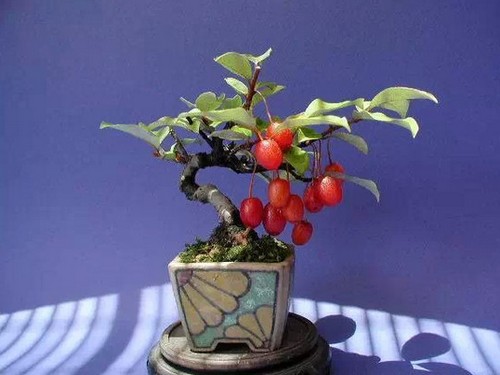Methods of making and managing bonsai of Berberis amurensis
Red leaf berries bloom yellow in spring and decorate red fruits in autumn. They are ornamental flowers and trees with beautiful leaves, flowers and fruits. They are suitable for planting as hedges in gardens or in corners of garden roads, with large flower beds edged or cut into spherical symmetries. Or embellished among the rocks or by the pool. Can also make bonsai, planting landscaping, widely used, good greening effect, high survival rate of transplanting, deeply loved by the people.

As long as you master the methods of production and management, you can make a good pot of red leaf Berberis. Now more and more people pay attention to decorative box gardening, the market of red leaf Berberis bonsai is also optimistic, those who are willing can try to make it.
Potted soil selection:
Just use ordinary garden soil to mix sand and soil. It is best to turn the basin every other year.
Reproductive techniques:
Berberis is propagated mainly by cutting method, but also by ramet and sowing method. Because of its strong adaptability, strong growth and extensive management, potted plants are usually divided into pots or transplanted in spring, and it is more conducive to recovery if they can be transplanted with soil balls. Red leaf Berberis has strong adaptability, cold tolerance and drought tolerance. Like plenty of light and cool moist environment, but also resistant to semi-overcast. It is suitable to be planted in sandy loam with good drainage, and the water requirement is not strict. If the soil is too wet at the seedling stage, the roots will rot.
Midsummer season should be kept in the semi-shade, other seasons should let it accept more light; watering should grasp the principle of wet between dry and dry, not without watering. Although this plant is more tolerant to drought, often drought is disadvantageous to its growth; if it can spray water to cool and humidify it when it is hot and dry, it will be of great benefit to its growth and development. Transplanting can be carried out from February to February in spring or from October to November in autumn, either with bare roots or with dirt. During the growth period, 20% liquid fertilizer such as cake, fertilizer and water should be applied once a month.
Suitable style:
Red leaf Berberis plant is relatively small, more suitable for making small and micro bonsai. If the style, you can choose a single plant to make, can be made into straight pole type, double pole type, oblique dry type, cliff type can also be made. You can use multiple plants in a pot to make jungle bonsai. It can also be embellished with other landscape bonsai.
Shaping and pruning:
It can be pruned into an artificial sphere, that is, strong pruning is carried out at the time of seedlings to promote new branches. Maintenance tree pruning can be carried out later. Plants that are too densely planted should be pruned again in 3-5 years in order to achieve the purpose of renewal and rejuvenation. From winter to early spring every year, the plants need to be properly trimmed, including dense branches, disease and insect branches, long branches and weak branches, and keep the branches evenly distributed into a ball. Red leaf Berberis is often cultivated as hedge because of its strong sprouting and resistance to pruning, and it is also suitable for small or miniature bonsai, mainly straight or oblique dry, or making jungle type.
The red leaf Berberis plant has strong germination ability and resistance to pruning. Panza can also be carried out. However, it should be noted that although the red leaf Berberis branches are relatively soft, but the branches with thorns, flat tie and pruning shape, do not stab fingers. In addition, when modeling, we must pay attention to: should be appropriate, clear levels, so as to have a more appreciative effect.
Cut off the wood:
Cut the red leaf Berberis panicle wood into 12-15 cm long cuttings with robust terminal buds. In order to improve the survival rate of cutting. After the cuttings were cut, 50 roots in a bundle, the base 2-3 cm immersed in 0.01% indolebutyric acid or ABT rooting powder solution for 30-50 minutes. It was cut before 10:00 and after 4 p.m. That day. The insertion depth is 2-3 cm, and the plant row spacing is 2.5 cm × 3 cm. Press gently after insertion, and drip with water, so that the cuttings are closely combined with soil cutting.
Fertilizer and water management:
20 days after insertion is the critical period for rooting, and the suitable time for each spray is to rotate the arm for 2 weeks, and to spray every 2-3 minutes every 2-3 minutes from 10:00 to 6 p.m. in sunny days, and every 10 minutes before and after 6 p.m. The interval time increased continuously after 20 days, and the interval was 50 minutes after 50 days. The number of spraying was reduced in cloudy days, and there was no spraying at night. Fertilization can supplement nutrients to cuttings and improve the survival of cuttings. The mixture of 0.2% urea and 0.3% potassium dihydrogen phosphate was sprayed every 7-10 days from 20 days after insertion to late September. The liquid volume is 0.5 kg per square meter. Extra-root fertilization was carried out after the spray was stopped in the evening. It is also necessary to control weeds and pests in time and carry out normal management.
Bonsai management:
During the growing period, the red leaf Berberis bonsai should be placed outdoors in a sunny, ventilated place. The color of the leaves will be beautiful only if there is enough light. At the same time, fertilizer should be applied regularly, and dilute liquid fertilizer can be applied every 20 days or so. March to April is the florescence, during this period, the leaves can also be applied with a little potassium dihydrogen phosphate solution.
Leaf management:
Old leaves can be trimmed properly from the end of August to early September. Urea spraying can give birth to new leaves, the new leaves are bright red and beautiful. It will make the bonsai a different landscape. Usually by the end of September, new leaves will grow. If there is sunshine in winter, you can move out for a few days at the right time.
Time: 2019-05-26 Click:
- Prev

DIY bonsai for mom
Mama Jordan recently fell in love with bonsai and wanted the whole garden in her heart, but the bonsai was so expensive that Joe decided to give DIY bonsai to her mother. DIY is not as simple as imagined. Jordan, with no foundation, went to a bonsai greenhouse in Jimo and asked professional teacher Liang Ming for advice. First
- Next

The method of making Elaeagnus angustifolia bonsai
Elaeagnus angustifolia, alias semi-Chunzi, sweet mallet, sparrow crisp, goat milk, scientific name E.pungens, native to China, temperate and subtropical regions of the Northern Hemisphere, belongs to Elaeagnaceae evergreen shrubs. The fruit tastes sweet and edible when ripe. Roots, leaves and fruits are all used for medicinal purposes. Natural plant shape, flower fragrance and fruit red
Related
- Fuxing push coffee new agricultural production and marketing class: lack of small-scale processing plants
- Jujube rice field leisure farm deep ploughing Yilan for five years to create a space for organic food and play
- Nongyu Farm-A trial of organic papaya for brave women with advanced technology
- Four points for attention in the prevention and control of diseases and insect pests of edible fungi
- How to add nutrient solution to Edible Fungi
- Is there any good way to control edible fungus mites?
- Open Inoculation Technology of Edible Fungi
- Is there any clever way to use fertilizer for edible fungus in winter?
- What agents are used to kill the pathogens of edible fungi in the mushroom shed?
- Rapid drying of Edible Fungi

